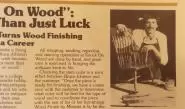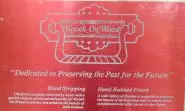A Long Story and a Hard Lesson

During a conversation I was having with a reporter last week, I was asked how I got started as a woodworker and antiques restorer, two of my former careers and still my favorite hobbies. After five years as a high school English teacher (yet another former career), I had spent six months trying to write The Great American Novel, no mean feat for a 27-year-old with no tragic life experiences to draw upon.
Soon after that a friend offered to buy me a beer at a local Iowa City watering hole called My Brother’s Place, where I shared with him my frustrations. After listening, he suggested that I get in touch with a junior high school shop teacher who also had a woodworking and refinishing business called House of Wood. I met Richard after school and he introduced me to Jim, a talented, 32-year-old woodworker who had recently moved from Colorado back to Iowa City to manage House of Wood and its three employees. Jim was a likeable, easy-going guy who, by his own admission, had done too much cocaine and too many hard drugs, and had come back home to Iowa City to get his life together.
A few days after I started, an elegant older man came into the shop. He was an antiques collector and former Atlanta dealer who had brought with him that day an early 19th-century cherry dropleaf table with two warped drop-leaves. Jim, who had no training or experience with antiques, decided the best way to flatten the warped drop-leaves would be to run them through our enormous, cast-iron planer.
I had my doubts, but no proof to back them up, so I stood at the discharge end of the planer to catch each drop-leaf as it emerged from beneath the whirling, razor-sharp, 24-inch wide blades. The first pass left a bright red streak of planed cherry at either end of the cupped drop-leaves. Jim looked at each leaf, then cranked the blades down a few turns. A second pass widened the two parallel bright red streaks, but still left a dark brown valley of original wood down the center. Determined, Jim cranked the blades down even further, despite the fact that we could all see that the wood at either of the cupped ends was now alarmingly thinner than the wood in the center.
When the first drop-leaf emerged from the third pass through the planer, the valley of dark brown wood had disappeared, along with the cupping, but my heart sank when I saw what had happened. Each leaf had been attached to the center section of the table with three hinges on the underside, each held on with three small brass screws. By the third pass, the wood over the hinges had become so thin that suddenly we could see a total of nine holes coming through the top of the wood.
This was a major disaster.

When he saw what he had done, Jim picked up a nearby board and hurled it across the shop and into a wall, then stormed out, headed over to our after-work bar, The Annex. We did the best we could, but the table was clearly ruined. A week later Jim finally worked up the nerve to call the client over to the shop. I don’t remember the antiques dealer saying anything, as Jim fell over himself apologizing profusely. He remained a true gentleman, calm and quiet, as we carried the deceased table out to his car and watched him drive away, never to return again.
It was a hard lesson to learn and one I have never forgotten — or forgiven myself for not warning Jim what the planer would do to that wonderful, old cherry table. Realizing how woefully inadequate woodworkers could be at restoring antiques, I began reading every book I could find on antique furniture, while making plans to open my own refinishing shop. For six months I slowly filled a storage unit with an assortment of second-hand tools I found at yard sales and community auctions until I was ready to give Richard and Jim my notice.
The next week I opened Knock On Wood Antique Repair and Restoration, which I ran for seven years before passing it along to my shop foreman and moving to North Carolina.
Jim eventually left House of Wood as well, doing what he loved best by finally opening his own woodworking shop. Unfortunately, he couldn’t leave behind the damage his carefree days in Colorado had done and a few years later, while working in his shop, his heart simply stopped.

Until next Monday,
Sometimes the most important lessons are the hardest ones to learn.
Bruce
Top: My first business logo.
Center: That’s me, not long after I opened Knock On Wood.
